Arranging a well at your dacha with your own hands: step-by-step instructions + advice from experienced craftsmen
You look inside your neighbor’s well and wonder how this can even be done? In fact, any owner of a summer cottage can build this simple and useful hydraulic structure with his own hands. The main thing is to want it.
We will tell you how and in what order the well is constructed, and we will tell you which method is more convenient and faster to carry out the work. The article we presented describes in detail the technology for constructing a mine water intake structure. Tips are given, following which you can easily arrange an autonomous water intake.
The content of the article:
Instructions for constructing a well
Any work begins with the acquisition of building materials and equipment. In this case, the list of building materials and tools is quite extensive. It’s better to prepare everything ahead of time, so that later you don’t have to go back and forth to the hardware store and be distracted from work.
And you should prepare the following:
- A shovel with a short handle that fits into the shaft.
- Scrap.
- Pump, preferably drainage model, capable of pumping out water containing sand particles, in other words, slurry.
- A strong rope, preferably nylon, or a sling for hanging the pump if the submersible version will be used.
- The hose to the pump of the appropriate length is the depth of the shaft plus the distance of the outlet from the work site.
- Buckets, preferably a couple.
- Lighting carrier-extension cord.
- An ordinary carrier so that it reaches the nearest outlet and allows you to power the same hammer drill and pump.
- A tripod with a hoist if the rings will be installed after the hole has been dug to the upper limit of the aquifer.
- Auxiliary boards and beams with which you can move, lift, and install rings if a hoist with a tripod is not provided.
- Hammer.
- Staples or anchor bolts with metal plates.
- Hammer, if staples are selected.
- Mortar is a ready-made mixture or cement with sand.
If everything you need has been prepared, we proceed to instructions on the actual construction of the well with your own hands.
Stage No. 1 - marking and beginning of work
Initially, the diameter of the hole should be slightly wider than the ring. We mark a circle of the required diameter and start digging. At the first stage, the ground may be hard, in some cases a crowbar may be required. But then things will go much easier.
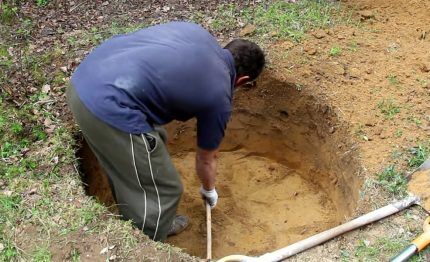
It will be unnecessary to say that the edges of the future well shaft must be strictly vertical to the horizon, and since a building level cannot be used in this case, we will control the vertical using the building plumb line. If you don’t have one, you can make such a tool yourself from a weight and ordinary rope.
Stage No. 2 - digging a well shaft
At this stage, you should immediately decide which method you will use to dig the well, open or closed.If the soil on the site consists of sand, sandy loam, water-logged gravel and crushed stone deposits interspersed with sandy filler, the well is dug using a closed method.
To avoid landslides and washouts, the first reinforced concrete ring is installed in a hole dug along its diameter at the initial stages of digging. The soil is removed from under the ring with a shovel and it falls down due to its gravity.

If the soil is dense and the walls of the mine do not collapse, since clays and loams predominate in the section, it is better to build a well in an open way. In this case, the mine is deepened without installing rings in it until the worker doing the digging reaches the upper groundwater horizon.
After this, the rings are lowered into the shaft, fastened together, and further deepening occurs using the closed type method.
Stage No. 3 - installation of concrete rings
If the shaft was dug using the open method, to lower the rings, a tripod is mounted on top, in the center of which a hoist is fixed. Each ring is mounted strictly lock into lock. Before installing each subsequent link, a special solution with the addition of plasticizers from water-resistant cement is applied to the bottom lock.
When they are all seated on top of each other, holes are drilled in the upper parts of the lower rings and in the lower parts of the upper rings using a hammer drill, into which stainless steel brackets are driven with a hammer. Three brackets or strips with anchor bolts are enough to prevent the rings from coming off each other as a result of heaving.

When constructing a well using the closed type method, each ring is placed on the next one as it deepens. Coating with mortar and fastening with staples is carried out here as the concrete shaft grows.
Stage No. 4 - equipping with a filter
In order for the filter in the well to not be a distraction, but actually perform its function, it must consist of three layers:
- Bottom – 25 cm of coarse quartz sand.
- Medium – 25 cm of small river pebbles.
- The top one is 25 cm of large river stone.
It is clear that when a well is equipped with such a powerful and effective bottom filter, you will have to deepen it as low as possible, equipping it with a kind of sump, since only one filter will take up a whole ring of your capacity.
Also, do not forget that the filter will have to be serviced periodically (the best is once a year), that is, washed or replaced with stones. Otherwise, the water quality will decrease.
If the well is intended only for watering the garden and other economic purposes, then you can do without a filter. What is it sump and how it looks can be clearly seen in the following diagram.
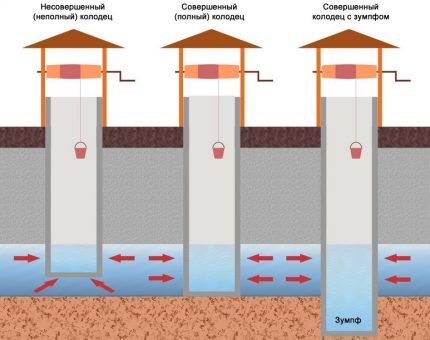
Stage No. 5 - clay castle and formwork
At the final stage, along the circumference of the well - at a distance of 3-5 meters from the shaft rings, the top layer of earth is raised and sealed with clay. This layer, subsequently covered with sand and gravel, will be called clay castle. On top of the sand and gravel cushion, it would be advisable to make concrete blind area. Not necessarily the same area as the castle, but at least 2-3 meters.
Everything is sealed so that the upper edge of the sand and gravel cushion (sand 15-20 cm, gravel 15-20 cm) reaches the level of the top layer of turf soil, and the formwork (7-10 cm) rises 5 cm above it.
A clay castle will protect the mine from reinforced concrete rings, which you can do with your own hands, from the abundant supply of moisture to their outer edges. This will prevent excessive heaving and, thereby, protect structural elements from shifting and penetration of dirt into the well shaft.
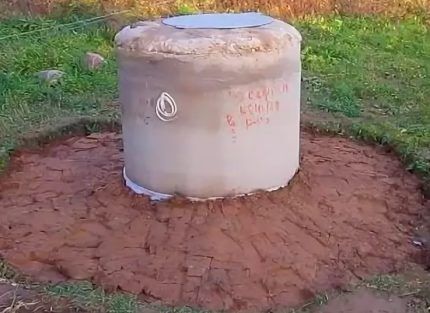
Formwork is needed in order to, in turn, protect the clay castle from being washed out and enhance its protective properties. In the end, a well with formwork around its circumference simply looks more aesthetically pleasing.
Stage No. 6 - arrangement of the upper part
You can insulate the formwork, as well as the top ring of the well, from frost. This is especially recommended in regions where winter is harsh and the top layer of the earth freezes thoroughly. Expanded polystyrene of hard grades is ideal as insulation, on which a sheathing is installed on top, and then plaster is applied.
With a lot of effort, you can make a real work of art from the upper part of the structure, which will not only diversify, but also significantly embellish your country landscape. Most often, the head is covered with stone, but with the help of wood you can give it a delightful look.
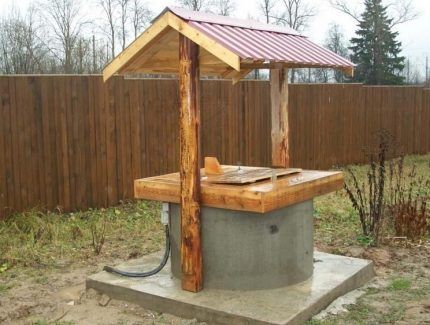
To protect against wind-blown debris, the well head must be covered with a tight lid. And to extend the service life of this cover, as well as the spit and other equipment, a visor is placed on top of the head.
Advice from experts on arrangement
Choosing a location for digging a well at the dacha or a personal suburban area is carried out in compliance with a number of rules.
It is erected according to certain rules, and here are the main ones:
- The water source cannot be located closer than 8 meters from the outdoor toilet.
- If the sewage system at the dacha is designed as an absorbent cesspool (septic tank without a bottom), and the well is intended for drinking water, then the well shaft should be located at least 50 m from it.
- In the case of a sealed cesspool or if the water will be used exclusively for watering the garden, this distance can be reduced to 20 m.
- Also, the water source should not be located close to silos. The distance to them should also be at least 8 m.
Here it is worth considering that the greater the distance of your well shaft from all kinds of structures that pollute groundwater, the better.
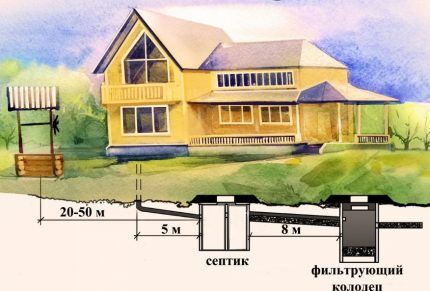
Tip No. 1 - time to carry out work
It is best to start work when the aquifer is at its lowest level. And it decreases significantly either during periods of prolonged drought, or after a month has passed after the first frosts hit.
Why during these periods? During these periods, water horizons are not recharged with water - in summer due to insignificant precipitation, and in late autumn and winter because the freezing upper layer does not allow water to penetrate into the earth.

Can dig a well and in normal times, but in this case, at the last stage you may not be able to penetrate well enough into the aquifer.
If you plan to make a filter, which is at least 60 cm, and have water in the well at least one ring high - 80 cm, then you will have to go deeper below the upper threshold of groundwater by about one and a half meters. And the easiest way to do this is in conditions where water does not remain constantly and at high speed.
But, if you rely entirely on a good pump that can pull slurry mixed with sand, then this is not a problem. In both cases, you will have to tinker in the slurry. And, of course, it is better if it is in warm weather.
Tip #2 - searching for groundwater
Many could see how some specialists, in search of water, walk around an area with two frames. Where they intersect, then, supposedly, the aquifer passes close to the surface.
To this we would like to note that any real hydrogeologist will tell you that:
- Water is everywhere and always, except, of course, when you live on the side of a mountain. If the terrain is more or less flat, then the groundwater belt lies, as a rule, at the same distance from the surface of the earth. If your site is hilly, in this case, it would be more acceptable to consider digging a mine in a low area.You can save money on 1-2, or even 3 rings, depending on what elevation changes your country landscape has.
- Searches using frameworks yield absolutely nothing. The effectiveness of this method has not been proven by scientists. Therefore, if you hire a home-grown specialist who practices this method, be aware that this specialist is most likely hanging noodles on your ears. Another thing is that you cannot prove this. As already mentioned, water is everywhere. And the fact that he made a mistake a couple of rings down or up, he will write off as the costs of the method, which he will warn you about in advance.
- The best way to find out at what distance the water lies is to either ask a neighbor on whose property there is already a well, or ask local geologists, drillers and meteorologists. They have engineering-geological maps, from which they will determine the depth of groundwater.
Well, when we have decided on a place, we go to get the rings and the necessary tools and equipment, if there is none at your summer cottage.
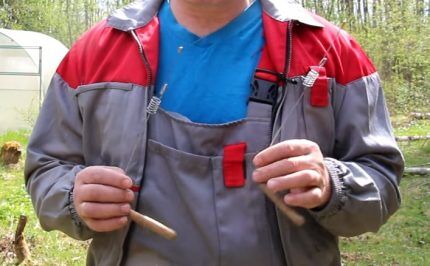
Tip #3 - choosing rings
It all depends on the diameter of your shaft. If you want to have a wide well, you can take wider rings. Of course, it takes longer to dig, but it is more convenient both to dig and to use. You can turn around properly, use a shovel with a longer handle, etc.
If you are satisfied with a narrow design, you can opt for rings of small diameter. In order to “get a feel for the situation,” you can climb into one of the rings right at the company and try to turn around in it.Whichever one will be more convenient to work in, take those.
The best option for a country well would be KS 10.9 tongue-and-groove, manufactured in accordance with GOST 8020-90. Of these, installing a shaft is a pleasure.
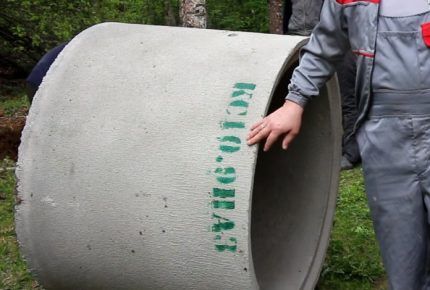
Tip #4 - what to do with quicksand?
Quicksand is a layer of silty clayey sand saturated with water. It resembles a dirty slurry in appearance; it is very difficult to obtain water from it: it is only possible as a result of long-term settling. And even then there will be too little of it, so extracting water from quicksand is pointless.
In general, the presence of quicksand in a section is an extremely rare geological situation. They are found only in glacial deposits, which are found, for example, in the Leningrad region. However, if you get caught, it would be advisable to go deeper below this layer. Only in this case will it be possible to ensure constant and rapid filling of the mine with water.
The process of overcoming quicksand is very labor-intensive. The legs are constantly being sucked in, and the accumulating water and slurry create additional difficulties in work. But if you want the well to be full, you will have to do this.
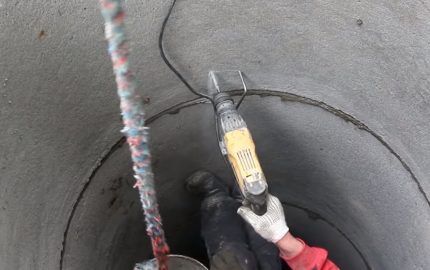
Tip #5 - don’t delay the work
It is advisable to carry out work on arranging a well in the country as soon as possible. Delaying the work using the open method will lead to the collapse of the pit walls.
And if in a situation with the open method, the situation can be corrected by cleaning the hole and covering the crumbled edges with earth after installing the rings in the shaft, then in the second case it may be necessary to use a crane.
Upon completion of digging the well and backfilling the bottom filter, it is advisable to pump out the first water from it. Then you must take water sample for analysisto submit it for laboratory testing. Only after this will it be possible to decide whether it can be used for technical or drinking purposes.
Conclusions and useful video on the topic
Those who would be interested in listening to expert advice in a slightly expanded and different version can watch the following video:
Work on arranging a well shaft is not as complicated as it is labor-intensive. And it is not always necessary to dig the earth's surface, going tens of meters into it.
Much more often the aquifer occurs at a depth of 4 to 7 meters. Taking turns, it is quite possible for two strong guys to dig such a mine in two days. The main thing is desire and tools!
Tell us about how you dug and equipped a well on your summer cottage with your own hands. Share technological subtleties that site visitors can use. Leave comments, post photos and ask questions in the block below.




We started work in winter, and even though the groundwater level was minimal, we encountered difficulties. It is difficult to dig frozen ground, so we heated it with a gas cylinder, and crushed the gravel layer with a jackhammer. I had to rent it, fortunately a company was found in the city. I had to plow for three days almost without stopping.And this despite the fact that the water is only 5 meters deep. So digging wells at any time of the year is difficult.
Hello. Allow me to supplement your article with practical advice. Firstly, I would advise treating the outer side of the rings with bitumen before installation, which will prevent surface water from entering the well through microcracks. And secondly, instead of brackets to hold the rings from moving, you can use a structure in the form of a letter - H, welded from plates. You just put a couple of these on top of the bottom ring, and put the top one in the groove. The connection is secure and there is no need for a hammer drill.